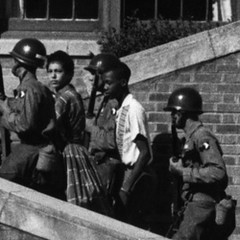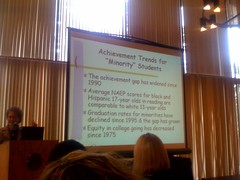 …and other lessons learned from the Kerner Forum.
…and other lessons learned from the Kerner Forum.
I just got off the phone with Karla, and it is about 2:30 am her time in Washington, DC on a Monday night. I had to call her because I am/was so tense about the state of our education system. After spending last Friday at the Kerner Forum on Education and Opportunity at Stanford, I realized that there is still so much to be done for our nation’s children. I felt like my hands were strapped behind my back because of the sheer immensity and gravity of the situation in which we, as a country, have gotten ourselves.
And Karla, being the stabilizing force that she is, ensured me that slowly but surely all of the micro-level things we are doing as a community and as organizations working with youth, schools, and teachers, add up, and join the momentum that is gradually being built up on a macro level, where the policy shifts need to start happening.
But above and beyond that, I feel a personal responsibility and calling to do more. And part of my issue is that I am so impatient that I want to get things done now, make big changes now, and be where I need to be professionally and personally so that I can start affecting change now.
And of course Karla brought me back to reality, and to steal from our new favorite musical, In The Heights: Paciencia y Fe (Patience and Faith).
Let me just briefly show you some of the information from the Kerner Forum that re-ignited some of my passionate fervor for educational equity.
The No Child Left Behind Act has failed
American educational disparities remain linked to funding disparities. The wealthiest 10 percent of school districts in the U.S. spend nearly 10 times more than the poorest 10 percent.
In the U.S., the highest performing students from low income families now enroll in college at the same rate as the lowest performing students from high income families. In other words, the smartest poor kids attend college at the same rate as the dumbest rich kids.
Achievement Rates for “Minority Students�
- The achievement gap has widened since 1990
- Graduation rates for minorities have declined since 1995 and the gap has grown
- Equity in college going has decreased since 1975
Progress since Brown v. Board of Education in 1954?
The desegregation movement is falling backwards. The peak of desegregation in schools happened in 1968 with about 47% of American schools being integrated. In the 2004, we are back down to pre-Brown v. Board of Education statistics with about 27% integration. What happened?
It’s so easy for us to think that race is not an issue any more, but when you look at schools these days, the wealthiest schools are where the high income White folks tend to flock to, while our low income urban schools continue to educate a majority of our Black and Latino kids.
I’m proud to say that I work with one of the most diverse schools in our nation, Menlo-Atherton High School (MAHS), but that is proving to be more of an outlier than the norm. And even within schools like MAHS, we can easily see what many of the Kerner Forum presenters called “Apartheid education,� where Whites and Asian-Americans are privy to special high-achieving tracks of education, like Advanced Placement classes, and Blacks and Latinos are relegated to remedial/intervention classes, even if they do not need to take them. Oh and I’ve seen this firsthand. I cannot tell you how many times it breaks my heart to see one of my students come in with her transcript showing me that she’s been “tracked� into business math or a second year of the same subject even if she doesn’t need it, only to find out later that it was a waste of time and won’t help her when she’s applying for college. And don’t even get me started on the students who are tracked into remedial English classes just because they speak a second language at home.
And yes, it hurts. I was one of those kids. I remember when they wouldn’t let me be part of the “Gifted, and Talented Education� (GATE) program at school because I had just moved to the country and couldn’t speak English as proficiently as a native speaker. Luckily, I was savvy enough to figure out the system, and I had the support from my parents and some special teachers to make sure that I was on the right path to college. But it’s so easy for a gifted and talented young person to fall through the cracks in today’s reality of Apartheid education. It’s segregation masked in progress.
It hurts, but it’s so validating for the work that we are doing.
Solution Space
If America’s number one route for “job training� is in our education system why do we put the least amount of resources into it? Our school system and infrastructure is based on antiquated industrial complex solutions. And the way we measure the success of our schools is boiled down to a numbers game: how many students graduate from high school?
Imagine if we held our schools to a higher expectation? What if we measured their success by how many students graduated from their school and went off to college? It seems like a minor shift, but it’s a reality that we cannot wait for others to create.

What we must do together as a nation
- Pay off the educational debt: Fund schools equitably, ensure pre-school and health care for all, and provide access to higher education.
- Invest in recruiting, retaining and distributing well-qualified teachers who can address diverse student needs.
- Redesign schools to support authentic learning and strong relationships.
- Create accountability system that use thoughtful assessments and are used for improvement rather than for punishment.
And according to Linda Darling-Hammond (pictured), co-director of Stanford’s Center for Opportunity Policy in Education, all of this could be done “for the cost of one week in Iraq.� While it can be easy to throw your hands up in typical 20th century-style apathy, as a nation, we cannot afford to ignore our educational crisis.
Can we act now to avoid an educational crisis akin to the $700 billion crisis in our financial sector?
Can we as adults advocate for our young generation who cannot vote?
Can our voices can get loud enough to be heard by superintendents, politicians, and policymakers?
Absolutely.
And in the meantime, let’s keep doing the good work we are doing because before you know it, the students who we were once supporting and encouraging through their algebra homework or presentation–be it Rosa, Freddy, Brianna or Vince–might be the ones standing by us as we fight for educational equity.
For more information, check out these recommended readings
Purpose of the Kerner Forum
The Kerner Commission responded to the wave of disorders around the nation from 1963 to 1967. They were called “riots� in the mainstream media, but often were called “rebellions� in the communities where they took place. The frequency of such violent group conflict diminished in later years – with a few notable exceptions, like the 1984 Liberty City disorders in Miami and the 1992 disorders in South Central Los Angeles after the first Rodney King trial verdict.Stanford Center for Opportunity Policy in Education
The Stanford Center for Opportunity Policy in Education (SCOPE) — an affiliate of the Center for Comparative Studies on Race and Ethnicity — and the Eisenhower Foundation will co-sponsor a daylong forum at Stanford to commemorate the 40th anniversary of the Kerner Commission report and to bring attention to issues of educational inequality.The initial report was released in March 1968, in response to the wave of civil disorders around the nation between 1963 to 1967. The report was written by the bipartisan National Advisory Commission on Civil Disorders, convened by President Lyndon Johnson.
The Commission (which became known as the Kerner Commission, after then-Illinois Governor Otto Kerner) believed that it was “time to make good the promises of American democracy to all citizens – urban and rural, White and Black, Spanish-surname, American Indian, and every minority group.� Forty years later, the Eisenhower Foundation, which periodically updates the commission findings, has released a preliminary report on the status of civil disorder today. The report is titled, What Together We Can Do: A Forty Year Update of the National Advisory Commission on Civil Disorders: Preliminary Findings.
The Stanford forum — “Education & Opportunity: A forum on the Kerner Commission Forty Year Report” — will feature plenary sessions and a townhall meeting. This event focuses in on education, as the foundation to create change in the much broader scope of poverty, inequality, racial injustice, and crime that the Kerner Commission addresses.
